“1, 2, 3, 4, 5, 6, 7, 8, 9, 2, 3, 12, 13, 14, 15, 16, 17, 18, 19, 20, 21, 22, 23, 24, 25, 26, 27, 28, 29, 30, 31, 32, 33, 34, 35, 36, 37, 38, 39, 40, 41, 42, 43, 44, 45, 46, 47, 48, 49, 50, 51, 52, 53, 54, 55, 56, 57, 58, 59, 60, 61, 62, 63, 64, 65, 66, 67, 68, 69, 70, 71, 72, 73, 74, 75, 76, 77, 78, 79, 80, 81, 82, 83, 84, 85, 86, 87, 88, 89, 90, 91, 92, 93, 94, 95, 96, 97, 98, 99, 4, 5, 102, 103, 104, 105, 106, 107, 108, 109, 6, 7, 112, 113… 996, 997, 998, 999, 8, 9, 1002, 1003, 1004, 1005, 1006, 1007, 1008, 1009, 2, 3, 1012…” –baby robot trying to count to ten, in base-10, for the first time.
Author: Andrew
13 March, 1781 (discovery of Uranus)
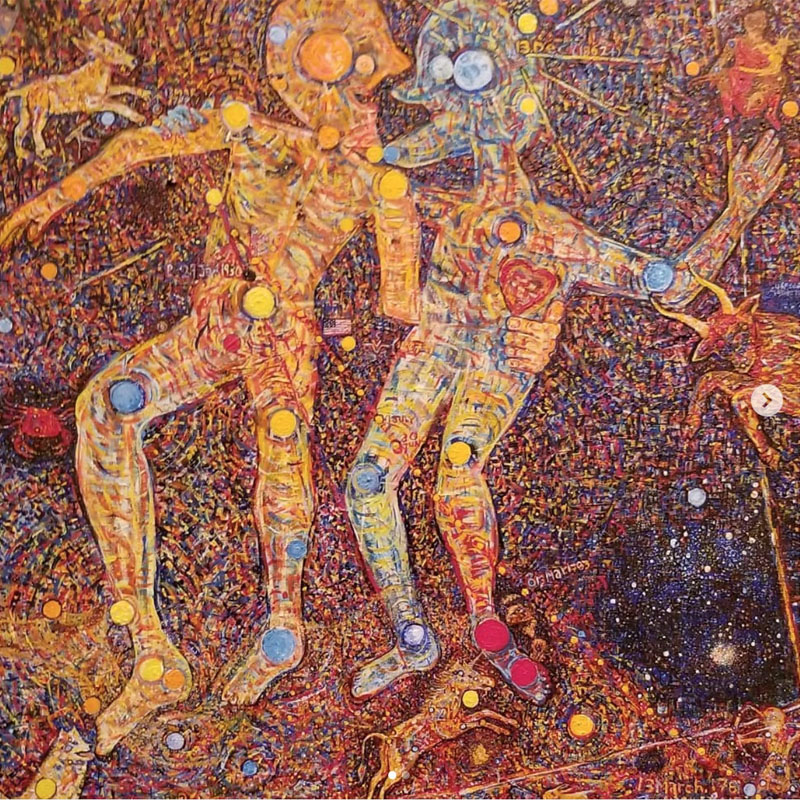
- On 13 March, 1781, while William Herschel was surveying the sky for probable double stars (which orbit each other), with his 40 foot telescope, then the largest in the world, he noted an object he could resolve to a disc, and, after some inquiry, it was established to be a planet, now known as Uranus. Interestingly, it had likely been *seen* before, over the centuries, but because it orbits so slowly (84 years) everyone thought it was a star. The scene of the discovery is the subject of this skyscape. The principal scene here is Gemini, where Uranus was that night (a handspan “up and left” from the readily-findable evening constellation Orion (also depicted here, along with the other neighboring constellations, in minature, though in celestial globe view)). Uranus is now in Pisces, and will return to this approximate location in 2033, only its third orbit since discovery.
Mars is in my in-progress slice of the sky
https://www.instagram.com/p/BoMVvbdAc7E/?utm_source=ig_web_copy_link
Lamb embroidery
Tough to follow a post like that, but I found this picture of a circa 2003 embroidered lamb jumping a fence in a garden on a tiny pillow. 
“21 Jan, 2014” (2017) (my favorite completed painting, to date)
I have a few bold claims and postures about this painting
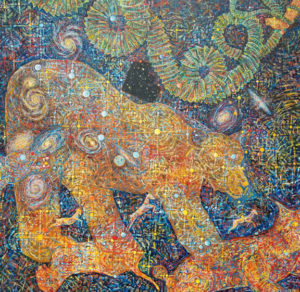
- For the past 2000+ years, everyone has misidentified Ursa Major, the Great Bear
- No painting ever completed has as its subject a larger total mass than this one.
- Chicago should adopt Chi Ursa Major as the official City Star.
Continue reading “21 Jan, 2014” (2017) (my favorite completed painting, to date)
note to self: get organized earlier in projects
I’ve made an ultimatum with myself to make my notes more sensible. I’ve been retoactively making neat, orderly diagrams.
https://www.instagram.com/p/BinTNzgHIUo/?taken-by=andrewlurie
https://www.instagram.com/p/Bg-Nr1dlDU-/
In which we discuss the superiority of eclipses on the Moon to those on Earth
https://www.instagram.com/p/BemZ5dtl2aN/
@algolwatch
hi. do you want to see a star get hundreds of times brighter or dimmer in a few hours? Algol is the “Demon Star” that disappears. Follow to know when.
https://www.instagram.com/p/BaEPVT7nSlx/
4 July, 1056
Winding down this work in progress. It celebrates one of the brightest human-seen supernovae. Over a few months, it brightened until brighter than Venus, then slowly faded. It is now known as the Crab Nebula, Messier 1. Orion is the human figure. I’ve also illustrated Lepus, the hare (Orion’s prey, illustrated as a plurality); Eridanus, the river; Monoceros, the Unicorn, Taurus, and the Bull. The Horsehead, Flame and Great Orion Nebulae are shown, as is Barnard’s Loop, part of the enormous star-forming Orion Molecular Cloud Complex, and some surprises.
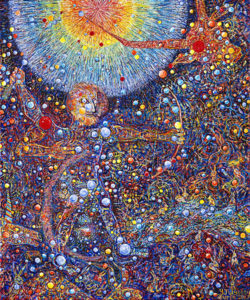
Solstice (2017)

Solstice actually occurs over in Gemini, up and to the right (radiating golden light), but Cancer is the subject, here. Praesepe, the Beehive Cluster, is the jewell of Cancer. In dark, dark skies, it is a barely noticeable, but distinct, fuzzy spot. It has been known since antiquity, always just out of sight, unknowable until telescopes brought it closer. Continue reading Solstice (2017)
Taurus/Pleiades 2017
Acrylic on canvas 2017
A more thorough reworking of Taurus’ famous Pleiades.
The Pleiades are an ethereal, glowing collection of several hundred stars, but just seven B and O spectrum stars are bare-eye visible, and several dozen are binocular-visible, which is the limit used in this painting. Gobs of space dust are lit by both the seen and unseen stars, creating one of the Northern sky’s great attractions.
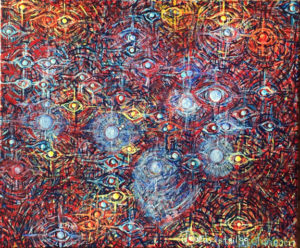
Lepus
Lepus, 2017. Acrylic on canvas. Lepus, the hare, is (to Northern viewers) at the foot of (and is the prey of) Orion. With two long ears and a curved back, it really does look bunny like, or Leporidae to pull the Latin. It even scales well to Orion. It has one nice globular cluster, M79 (Messier 79). Acrylic on canvas 2017.
)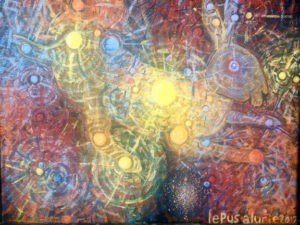
Cow Jumping Over the Moon
Oil on canvas, 24×36, 2016. The familiar subject of children’s lore, at home passing through Taurus, with it’s two great clusters, the Hyades and the Pleiades. 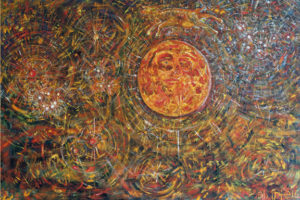
Cthulhu tile
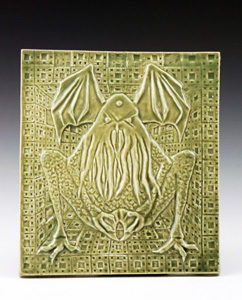
Everyone’s favorite Ancient One. Celadon on porcelain. For the obligatory non-euclidian geometry I used a Menger Sponge.
Chicago Flag
 Underglaze and glaze on terra-cotta. Side note: the construction of a Chicago Star is a fun compass and straightedge project.
Underglaze and glaze on terra-cotta. Side note: the construction of a Chicago Star is a fun compass and straightedge project.
Chair tiling tiles (set of 20)

27 of a single shape, rotated seemingly randomly, fill each square tile. Glazed, seemingly randomly, in four greyscale colors
Skull tile
 Soda fired skull with Cohen’s Red glaze
Soda fired skull with Cohen’s Red glaze
Root 3 triangles
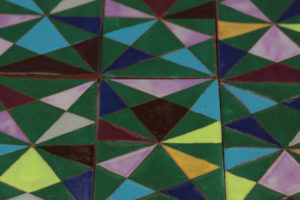 A 30-60-90 triangle, aka X, 2X, (root 3)X triangle flip flopping around, with associated forms. Shown in 3 color ways: erratic polychrome, red and white, and black and white.
A 30-60-90 triangle, aka X, 2X, (root 3)X triangle flip flopping around, with associated forms. Shown in 3 color ways: erratic polychrome, red and white, and black and white. 
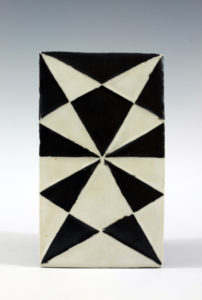
Large Geometric Tile
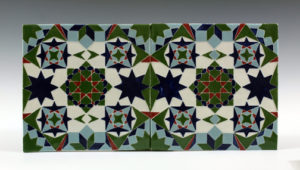 Just a playful geometric with 4,5, 8, 10, 12, 16. 180 symmetrical design. Colors are modeled off of Iznik tile, but the doodle is my own .Underglazes, glaze on porcelain.
Just a playful geometric with 4,5, 8, 10, 12, 16. 180 symmetrical design. Colors are modeled off of Iznik tile, but the doodle is my own .Underglazes, glaze on porcelain.